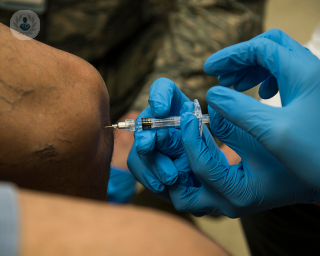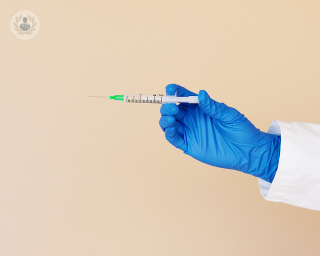Joint injections
Mr Ansar Mahmood - Orthopaedic surgery
Created on: 11-13-2012
Updated on: 11-08-2023
Edited by: Aoife Maguire
What are joint injections?
Joint injections are administered in a joint or periarticular soft tissue that is affected by inflammation.
Injections – when prescribed correctly – can be an excellent solution for problems such as bursitis or tendonitis, or for physical discomforts that prevent daily activities from being carried out. Therefore, joint injections can provide relief, as well as reduce pain.
Different liquid substances can be injected, including joint components such as collagen or hyaluronic acid, anti-inflammatory or growth factors and platelet rich plasma (PRP).
With injections, rheumatic conditions can be treated - arthritis, bursitis, tendonitis, epicondylitis or nerve entrapments. Other conditions such as trigger finger, carpal tunnel syndrome or frozen shoulder can be treated with injections too.

What are joint injections used for?
These injections can be applied to both larger joints, such as the knee, wrist or shoulder and in the surrounding tissues, such as ligaments or tendons.
Joint injections can be used to treat two different types of joint disease:
- Degenerative joint disease: those caused by wear and tear (e.g. arthritis).
- Inflammatory joint disease: those in which the synovial membrane is affected, such as rheumatoid arthritis.
How are joint injections given?
A joint injection is injected into the area being targeted. It is a simple technique and can be carried out on an outpatient basis.
Joint injection preparation
An injection does not require extensive preparation. The specialist should know the patient's medical history, as well as medications to which the patient may be allergic.
Aftercare
Once the injection is given, the patient should keep the injected limb at rest during the first 24 hours, as well as take any painkillers indicated by the specialist. Ice may also need to be applied to the area too in the first few hours.
If any intense pain, colour changes in the injected area, or fever after the intervention are experienced, the patient should immediately return to see their specialist.
Alternatives to joint injections
If joint injections are not suitable for the patient, the specialist may also recommend physiotherapy, anti-inflammatory medications, and in more severe cases surgery. Joint injections may be administered by various specialists, including GPs, pain medicine specialists, rheumatologists and orthopaedic surgeons.
















